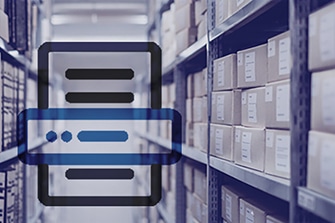Data Extraction: How to Transform Unstructured Data into a Valuable Resource
What is Unstructured Data and How Does Data Extraction Help?
February 18, 2020
Data is one of the most important decision-making tools in business. Making data-based decisions can result in higher efficiency and increased profits but it’s not just about money. Data can be human-centered and help drive changes that improve customer experience, enhance patient care, and help meet greater needs in society such as resource allocation and disaster recovery.
Every day our digital interactions and processes are generating tons of data. Every form, document, and communication your company produces has the potential to contain useful data. It’s easy to see why this data is important. The question is, how can a business best access and leverage the data they actively collect? To better understand the answer, it’s helpful to know the difference between structured and unstructured data.
Types of Data
Structured Data: Is data that exists within a fixed field inside of a record or file. It includes data that resides in relational databases and spreadsheets. Structured data is easier to plug-in to tools like data visualization software. It exists in a coded format such as a .JSON file which many data-centric software applications can read.
Unstructured Data: This is the most common form of document data. The content within a document that contains unstructured data does not have tagged/defined fields. In the end, computers, software, and many integrations cannot ingest this data as is, because it cannot distinguish the relationships between elements. PDFs, text files, Word documents and media logs are examples of unstructured data.
Semi-Structured Data: This type of data does not exist in the formal architecture that structured data does. It does, however, contain tags or other markers to define the data. It has some organizational properties that make it easier to analyze. An XML spreadsheet is an example of semi-structured data.
Unstructured documents make up a lot of the records that businesses produce. Bills, receipts, financial files, contracts, personnel files, and forms are all typically in an unstructured format. However, once you have that order form, survey, customer profile, or patient record how do you accurately capture the data in order to make it useful? This is where data extraction comes in. Data extraction involves getting data or information from one source to another for further processing and analysis. With data extraction, you can turn huge collections of unstructured information into accessible, relational databases that integrate with data analysis tools, automatic workflows, and more.
Why do you Need Data Extraction?
The documents you generate and the data you collect have a purpose – you wouldn’t expend the energy gathering them otherwise. Whether you plan to use it for compliance, delivering services, marketing, customer relationship building, or trend analysis the data you collect is valuable. However, it can be difficult to access this wealth of information if your documents are in unstructured or analog formats like paper. Likewise, unstructured data in digital documents like PDFs may require someone to manually read and transfer the data so it can be used to build prediction models, databases, or other aggregated outputs.
Depending on the volume of unstructured data, this is often labor-intensive. When reaching your data becomes too difficult it sometimes stays trapped in a digital data warehouse or filing cabinet. Ignoring your unstructured data because it’s hard to reach is like sitting on a gold mine without the tools to dig it out.
Data should be driving your business decisions, not languishing in storage. So, what is the solution to this problem? Manually, transcribing or converting years of forms, files, contracts, and billing statements is simply not economical. Fortunately, advanced data processing tools can quickly and intelligently capture the data you need. With data capture, the process of locating, compiling, and exporting specific types of data can be automated through technology like machine learning or natural language processing. Depending on the customer’s needs, a data extraction tool can select and source data based on keyword, form field, or location. The resulting information can then be compiled and exported or transferred to a custom-built workflow.
Use Case Example
The Challenge:
A real estate brokerage firm needs to process hundreds of rental applications a month. Potential renters fill out a digital PDF form with their information and then email it to the firm. First, an employee must review each rental application manually to determine which applications are complete. Next the employee sorts them into groups based on which property the application is for. Finally, the employee must gather and submit the information needed to conduct a background check for the potential tenant. The applicant’s personal information is separately added to a contact list spreadsheet and promotional email list. Each application takes approximately half an hour to process. This results in hundreds of man-hours and a considerable margin for error in transferring the data.
Even though everything the employee needs is available digitally within the PDF file, it is unstructured data. As a result, all of the contained information is essentially grouped together without tags or context relationships. Human input is required to determine whether a collection of characters at the top of the page is a name, a title, a date, or something else.
The Solution:
With data extraction, the entire application review process could be automated. Instead of manually crawling through the document, a digital tool can identify the document as a rental application. First, it does this by automatically by looking for keywords, a barcode, form number, or other included identifier. Once the document is identified the tool can be “taught” where to look for the information needed to conduct a background check. After locating this information, it can pass the needed data and submit the background check automatically. Finally, the applicant can be added to a Customer Relationship Management (CRM) platform that notifies them when their application is under consideration. Processed applications can be archived, and incomplete documents can be routed to an employee for manual review. All of this and more is achievable through a thoughtful pairing of data extraction, workflow development, and software integration.
Data Extraction Benefits
Accuracy & Quality Control:
Human-guided methods of extraction are prone to errors such as typos, missing information, or duplicates. In addition to being faster, digital data extraction is significantly more accurate and consistent. However, in cases where a human decision is needed, documents can be re-routed to a human employee to be double-checked.
Improved Decision Making:
When your data is accessible it becomes a valuable decision-making tool. Backing your financial decisions with clear metrics can make a huge difference in your bottom line. In addition to helping you drive growth; easy data access can make a significant difference in operations. Additionally, data capture can be paired with advanced search tools to allow you pinpoint the exact data you need. For example, locating all customers within a specific area or by the interest rate of their individual loan.
Reduced Labor Costs:
Manual data extraction is very time-consuming. Digital Transformation and technology integration can improve your business by freeing employees to do more involved, critical thinking focused tasks. Utilize people where they are most engaged and impactful by including automation. Ultimately you will reap the benefits of improved productivity.
How DOMA Does Data Extraction
DOMA uses highly effective, cloud-based tools to facilitate data extraction for our customers. We can also help our customers prepare a more inclusive document management strategy that incorporates automated workflows, electronic document storage, and other digital transformation strategies. Our software platform and standalone digital solutions are scalable and integrate readily with the platforms and workflows you’re are already using. Above all, we can help you build a comprehensive information management strategy that addresses multiple needs within your organization and takes advantage of the best tools the field of data extraction has to offer.
About DOMA- Powered by Tech, Driven by People
DOMA Technologies (DOMA) is a software development and digital transformation company whose mission is to change customer lives by lightening their workload through faster and more targeted access to their data. Since 2000, our team of 200+ experts has helped businesses navigate all aspects of the digital world. We are a dedicated strategic partner for the federal government and private sector clients at every stage of their unique digital transformation journey.

Author:
Danielle Wethington
Director of Communications
Digital Solutions
Learn more about DOMA’s Digital Solutions
Recent News

Data-Driven Sustainability for a Healthier Future

Humanizing Healthcare

Reducing Improper Payments

